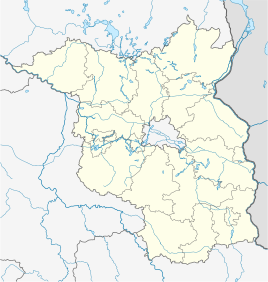Glindow
|
Glindow
City of Werder (Havel)
Coordinates: 52 ° 21 ′ 54 ″ N , 12 ° 54 ′ 35 ″ E
|
||
|---|---|---|
| Height : | 33 (32-69) m | |
| Area : | 12.9 km² | |
| Residents : | 3600 | |
| Population density : | 279 inhabitants / km² | |
| Incorporation : | December 31, 2001 | |
| Postal code : | 14542 | |
| Area code : | 03327 | |
|
Location of Glindow in Brandenburg |
||
Glindow has been part of Werder (Havel) since the Brandenburg municipal reform in 2001 . The place has been a center of the brick industry since the Middle Ages. The yellow clinkers typical of the Mark Brandenburg were produced from the Glindow clay.
history
Glindow was first mentioned in 1317 with the Slavic place name Glina , which translates as clay or loam .
Since 1462 the monastery Lehnin took over the direction of the brick production. In the 19th century, the demand for building materials exploded in fast-growing cities, especially in Berlin. The Glindow brickworks had the advantage that their products could be loaded directly onto barges and transported to cities at low cost. Approx. 18 brickworks were built in Glindow, the approx. 50 round furnaces with twelve chambers operated. At peak times the daily production per chamber was 12,000 stones, so that the approx. 500 brickworkers produced up to 600,000 bricks every day.
So Glindow was raised to the district in 1872. From 1906, the clay stocks in the Glindow area were exhausted and the brickworks began to die. The global economic crisis in 1929 almost killed the Glindow brick industry, in 1935 there were still 2 brick factories.
In World War II , production is completely stopped. VEB Ziegelwerke Glindow has been supplying building materials again since 1948, and flower pots have been produced in VEB Tonwaren Glindow since 1959.
With the change came the temporary end for the pottery production. The brick factory became a museum . Since 1990 building materials for the reconstruction of monuments have been made by hand in the museum, just like in the old days.
Glindow was incorporated into Werder (Havel) on December 31, 2001.
The place
Glindow is west of Werder on the B 1 . The Glindowsee is connected to the Havel by the Strenggraben, an artificial waterway that was created around 1701 . Over this Strenggraben the Strengbrücke leads the Bundesstraße 1 in a south-easterly direction to the Baumgartenbrücke near Geltow . At the time of the merger with Werder, Glindow had almost 4,000 inhabitants.
Attractions
- The Glindow village church was built in 1852/1853 according to plans by August Stüler . However, the construction was carried out under the direction of the Schinkel student and building inspector Christian Heinrich Ziller (1791–1870), an uncle of the Ziller brothers, who later built in Saxony, and Ernst Ziller, who worked in Greece . A neo-Gothic nave was built from Joachimstal brick , the east wall of which ends with a stepped gable. The enclosing walls of the old church made of field stones were included. The bell tower is a remarkable 40 meters high.
- Brickwork Museum
- Glindower Alps nature reserve
- The area is characterized by fruit growing.
Glindower Alps nature reserve
The Glindower Alps nature reserve is a remnant of the brick industry. This landscape, untypical for the Mark Brandenburg , was created as an overburden dump for clay extraction.
literature
- Address book for the cities of Babelsberg, Werder and the municipalities, Bergholz-Rehbrücke, Caputh, Drewitz, Fahrland, Ferch, Geltow, Glindow, Krampnitz, Michendorf, Peztow, Saarmund, Sacrow, Wilhelmshorst , 1938/39, reprint facsimile, ISBN 978-3- 88372-037-1 , Potsdam 2013
Web links
Individual evidence
- ↑ Dr. Gebhard Falk "How old is Glindow" in contributions to local history from 1990
- ↑ Glindow website accessed on June 9, 2015
- ↑ StBA: Changes in the municipalities in Germany, see 2001


